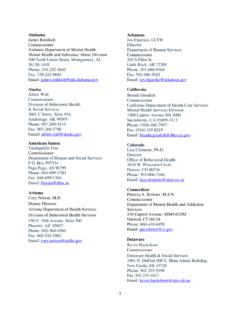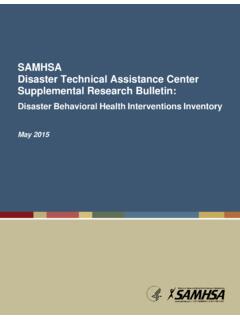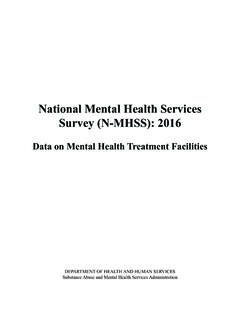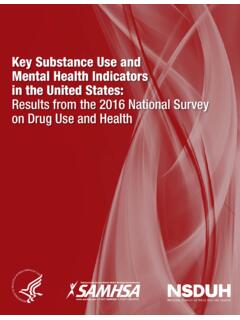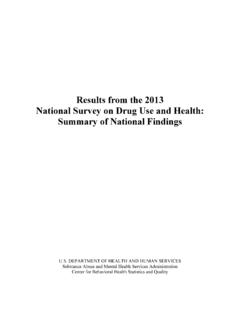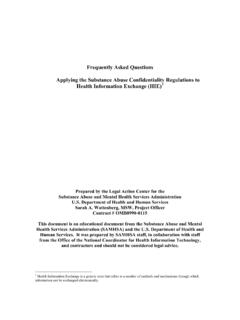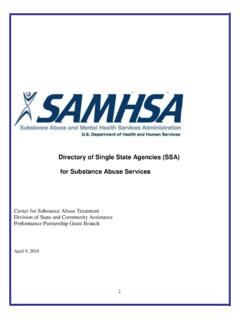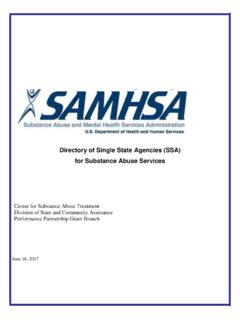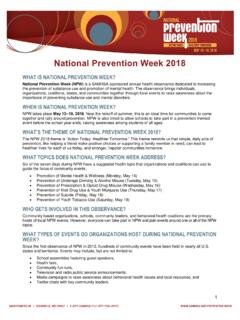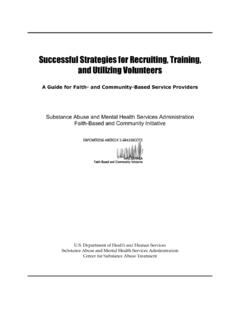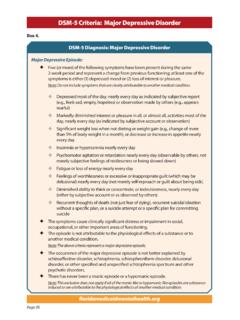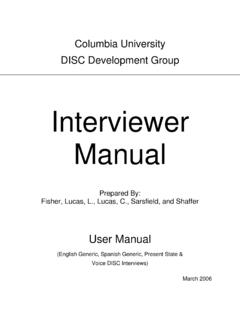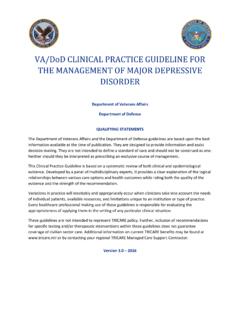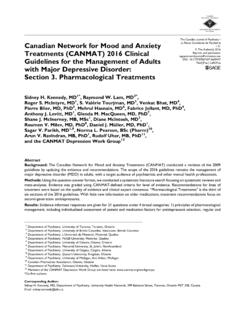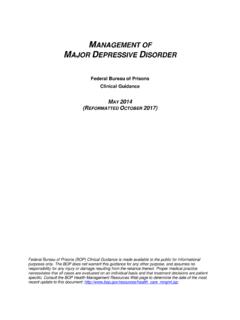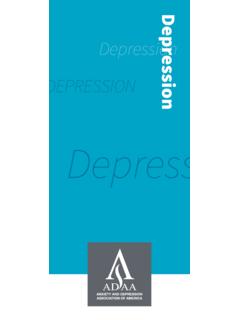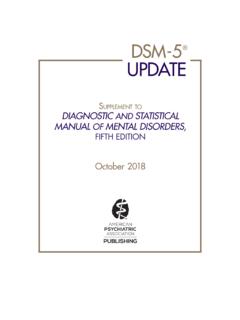Transcription of Highlights for the 2020 National Survey on Drug Use and Health
1 1 Highlights for the 2020 National Survey on Drug Use and Health Tobacco Product Use or Nicotine Vaping In 2020, of people aged 12 or older (or million people) used nicotine products( , used tobacco products or vaped nicotine) in the past month. Among past month users of nicotine products, nearly two thirds of adolescents aged 12 to17 ( ) vaped nicotine but did not use tobacco products. In contrast, of pastmonth nicotine product users aged 26 or older used only tobacco products. Alcohol Use In 2020, of people aged 12 or older (or million people) used alcohol in thepast month ( , current alcohol users Among the million people who were current alcohol users, million people ( ) were classified as binge drinkers and million people ( of current bingedrinkers and of current alcohol users) were classified as heavy drinkers. The percentage of people who were past month binge alcohol users was highest amongyoung adults aged 18 to 25 ( ) compared with of adults aged 26 or older of adolescents aged 12 to 17.)
2 Illicit Drug Use In 2020, of people aged 12 or older (or million people) used illicit drugs inthe past year, including (or million people) who used marijuana. The percentage of people who used marijuana in the past year was highest among youngadults aged 18 to 25 ( ) compared with of adults aged 26 or older and adolescents aged 12 to 17. Among people aged 12 or older in 2020, (or million people) misused opioids inthe past year. Among the million people who misused opioids in the past year, people misused prescription pain relievers and 902,000 people used heroin. Initiation of Substance Use Among people aged 12 or older in 2020, million people initiated cigarette smoking, million initiated alcohol use, million initiated marijuana use, and millioninitiated prescription pain reliever misuse in the past year. The vast majority of people who were past year initiates of cigarette smoking or alcoholuse tried cigarettes or alcohol for the first time before age 26.
3 In contrast, nearly twothirds of past year initiates of prescription pain reliever misuse were aged 26 or olderwhen they initiated misuse. Perceived Risk from Substance Use Only about one fourth of people aged 12 or older in 2020 ( ) perceived great risk ofharm from smoking marijuana once or twice a week. Young adults aged 18 to 25 were less likely than adolescents aged 12 to 17 or adults aged26 or older to perceive great risk of harm from smoking marijuana weekly. Substance Use Disorder The 2020 Survey marked the first year in which substance use disorders (SUDs) wereassessed using the criteria defined in the Diagnostic and Statistical Manual of Mental2 Disorders, 5th edition (DSM-5), as opposed to criteria specified in the Diagnostic and Statistical Manual of Mental Disorders, 4th edition (DSM-IV). In 2020, million people aged 12 or older (or ) had an SUD in the past year,including million with alcohol use disorder, million with an illicit drug usedisorder, and million with both alcohol use disorder and an illicit drug use disorder.
4 Mental Health In 2020, of adolescents aged 12 to 17 (or million people) had a majordepressive episode (MDE) in the past year, and (or 644,000 people) had a co-occurring MDE and an SUD in the past year. In 2020, of adults aged 18 or older (or million people) had any mental illness(AMI), and (or million people) had serious mental illness (SMI) in the pastyear. An estimated of adults aged 18 or older in 2020 (or million people) had co-occurring AMI and an SUD, and (or million people) had co-occurring SMI andan SUD in the past year. Suicidal Thoughts and Behavior In 2020, of adults aged 18 or older (or million people) had serious thoughts ofsuicide, (or million people) made a suicide plan, and (or millionpeople) attempted suicide in the past Whites aged 18 or older, (or million people) had serious thoughts ofsuicide, (or million people) made a suicide plan, and (or 741,000people) attempted suicide in the past people of two or more races aged 18 or older, (or 514,000 people) hadserious thoughts of suicide, (or 155,000 people) made a suicide plan, and (or 57,000 people) attempted suicide in the past Hispanics or Latinos aged 18 or older, (or million people) hadserious thoughts of suicide, (or 503,000 people) made a suicide plan, and (or 243,000 people) attempted suicide in the past year.
5 Among adolescents aged 12 to 17, (or million people) had serious thoughts ofsuicide, (or million people) made a suicide plan, and (or 629,000 people)attempted suicide in the past year. Substance Use Treatment In 2020, of people aged 12 or older (or million people) were classified asneeding substance use treatment in the past year. These findings were consistent with theSUD data. Among people aged 12 or older in 2020 who needed substance use treatment but did notreceive treatment at a specialty facility in the past year, did not feel that theyneeded treatment. Mental Health Service Use In 2020, of adolescents aged 12 to 17 (or million people) received mentalhealth services in a specialty setting in the past An estimated of adults aged 18 or older in 2020 (or million people) receivedinpatient or outpatient mental Health services or took prescription medication for a mentalhealth issue in the past year.
6 Less than half of adults aged 18 or older in 2020 with AMI ( ) received mentalhealth services in the past year. About two thirds of adults aged 18 or older with SMI( ) received mental Health services (but about one third did not). About half of adults aged 18 or older in 2020 with SMI ( ) perceived an unmet needfor mental Health services in the past year. Service Use among People with Co-Occurring SUD and Mental Health Issues About half of adults aged 18 or older in 2020 with a co-occurring SUD and AMI in thepast year received either substance use treatment at a specialty facility or mental healthservices in the past year ( ), but only received both services. About two thirds of adults aged 18 or older with a co-occurring SUD and SMI in the pastyear received either substance use treatment at a specialty facility or mental healthservices in the past year ( ), but only received both services.
7 Perceived Effects of the COVID-19 Pandemic In Quarter 4 of 2020 (October to December), adolescents aged 12 to 17 who had a pastyear MDE were more likely than those who did not have a past year MDE to perceivethat the coronavirus disease 2019 (COVID-19) pandemic negatively affected their mentalhealth quite a bit or a lot. Similarly, adults aged 18 or older who had AMI or SMI in thepast year were more likely than adults who did not have mental illness to perceive that theCOVID-19 pandemic negatively affected their mental Health quite a bit or a lot. In Quarter 4 of 2020, million past year users of alcohol and million past yearusers of drugs other than alcohol perceived that they were using these substances a littlemore or much more than they did before the COVID-19 pandemic began.
